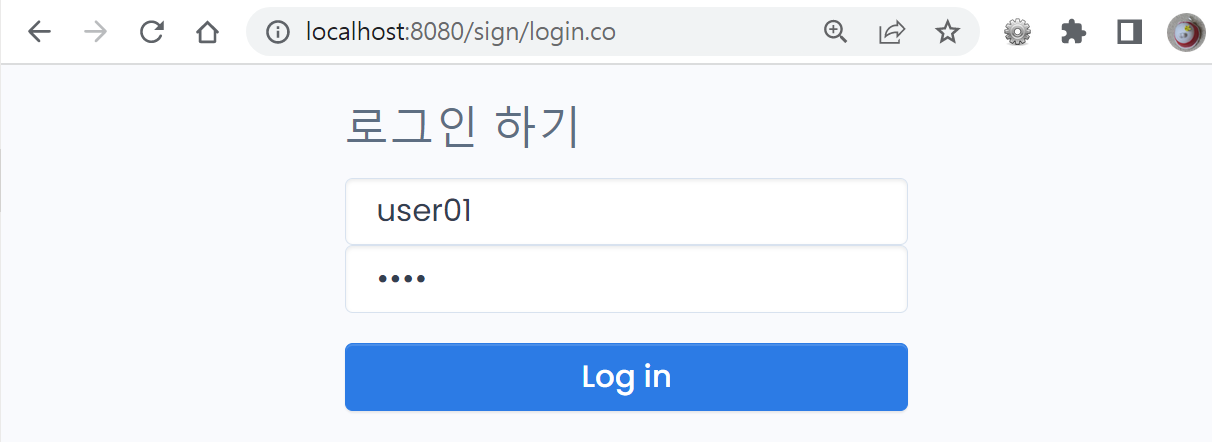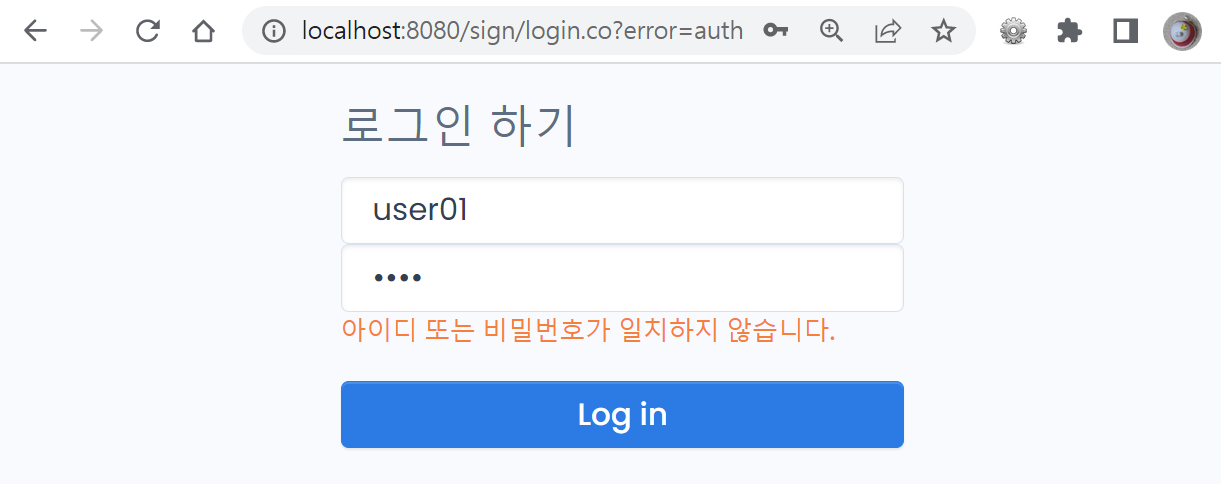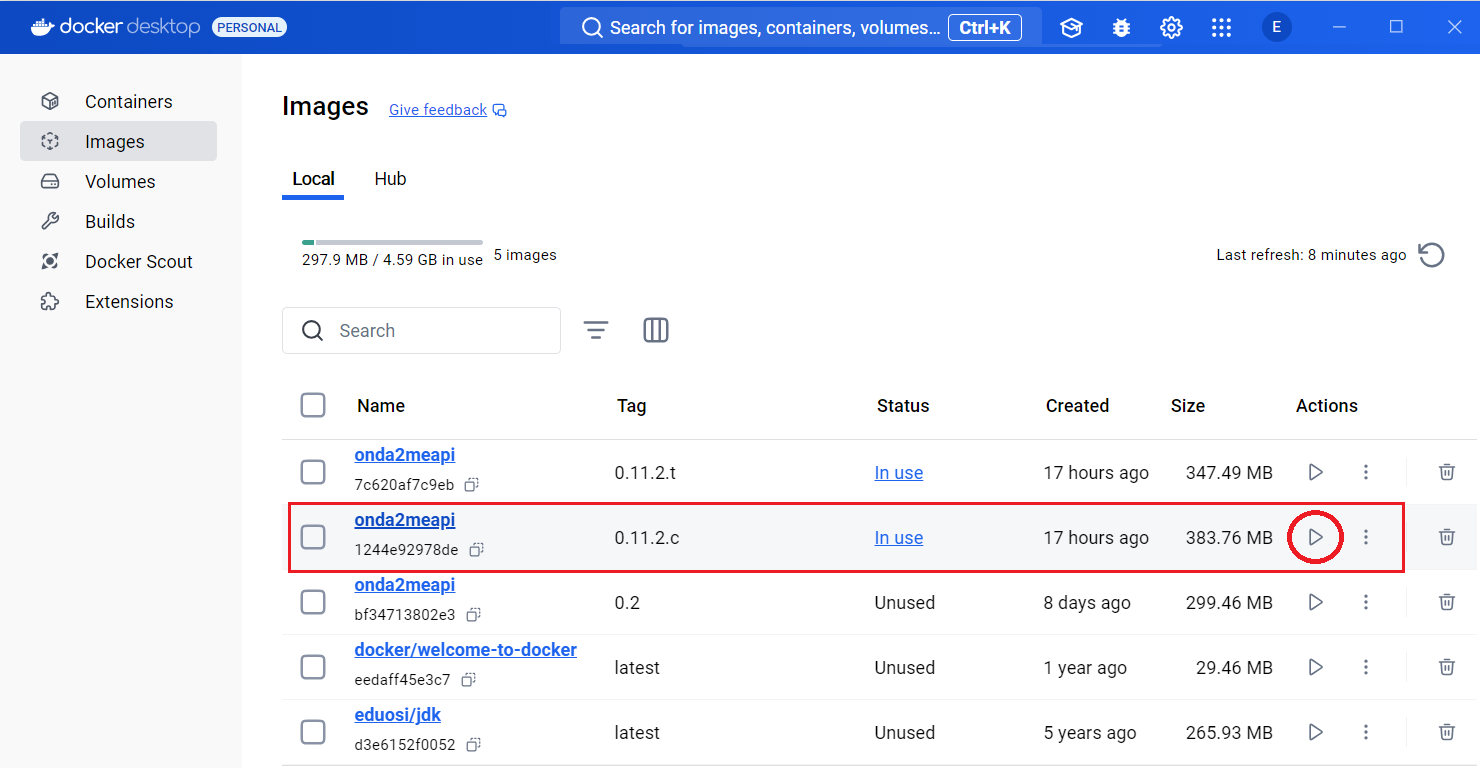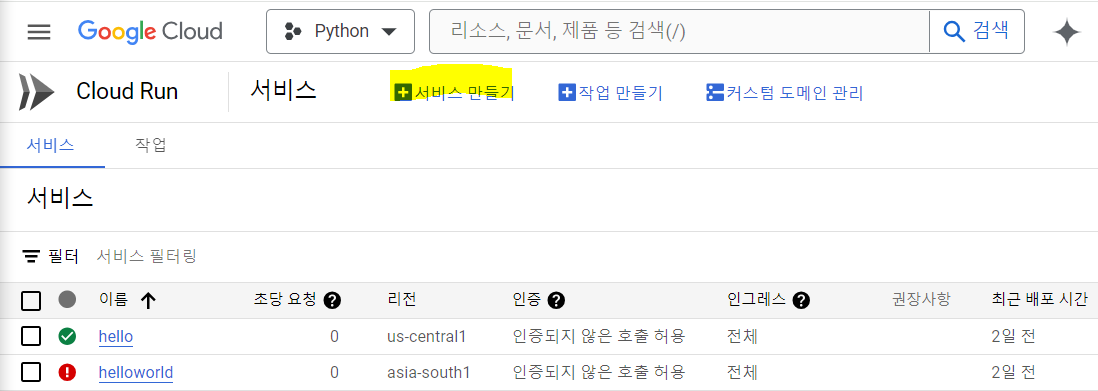Spring MVC 프로젝트에서 Spring Security 5.0.7를 이용한 접근권한 관리하기
Spring Security는 스프링 기반 어플리케이션의 보안과 인증을 담당하는 프레임워크로,
Spring Security를 Filter에 추가하여 동작하기 때문에 Spring MVC와 분리되어 동작한다.
이 글은 Spring Security 5.0.7.RELEASE 를 기반으로 접근권한을 설정하였으며, 이전버전(3.1.1)의 설정은 이전글 보기를 참고한다.
Spring Security는 페이지별 접근권한을 설정파일로 관리하며, 디렉토리별로 또는 개별 페이지마다 권한 설정이 가능하다.
인증에 따른 접근권한은 아래와 같이 설정할 수 있다.
- 로그인페이지 (/sign/loginForm.co)는 로그인을 하기위한 주소이므로 로그인 없이 접속이 가능해야 하고,
- 마이페이지 (/mypage/view.co)는 로그인한 사용자만 접속이 가능해야 하며,
- 사용자 관리페이지 (/admin/user/list.co)는 로그인한 관리자만 접속이 가능해야 한다.
@ 개발환경
- Eclipse 2021-06 (4.20.0) + Spring Tools 4
- Java 1.8
- MySQL
@ 접근권한 설정 예
<intercept-url pattern="/sign/**" access="permitAll" /><!-- 로그인 없이 접근 가능 -->
<intercept-url pattern="/mypage/**" access="isAuthenticated()" /> <!-- 로그인 후에만 접근 가능 -->
<intercept-url pattern="/admin/**" access="hasAnyRole('ROLE_ADMIN')" /><!-- ADMIN 권한 접근 가능 -->
<intercept-url pattern="/user/**" access="hasAnyRole('ROLE_USER','ROLE_ADMIN')" /><!-- USER와 ADMIN 권한 접근 가능 -->
<intercept-url pattern="/report/view.co" access="hasAnyRole('ROLE_USER')" /><!-- USER 권한 접근 가능 -->
<intercept-url pattern="/report/update.co" access="hasAnyRole('ROLE_ADMIN')" /><!-- ADMIN 권한 접근 가능 -->
1.Spring-Security Library 추가
@ pom.xml
<properties>
<java-version>1.8</java-version>
<org.springframework-version>5.3.22</org.springframework-version>
<org.springsecurity-version>5.0.7.RELEASE</org.springsecurity-version>
</properties>
<!-- Spring security -->
<dependency>
<groupId>org.springframework.security</groupId>
<artifactId>spring-security-web</artifactId>
<version>${org.springsecurity-version}</version>
</dependency>
<dependency>
<groupId>org.springframework.security</groupId>
<artifactId>spring-security-config</artifactId>
<version>${org.springsecurity-version}</version>
</dependency>
<dependency>
<groupId>org.springframework.security</groupId>
<artifactId>spring-security-core</artifactId>
<version>${org.springsecurity-version}</version>
</dependency>
<dependency>
<groupId>org.springframework.security</groupId>
<artifactId>spring-security-taglibs</artifactId>
<version>${org.springsecurity-version}</version>
</dependency>
2. Spring-Security 설정파일 생성
@ security-context.xml
<?xml version="1.0" encoding="UTF-8"?>
<beans:beans
xmlns="http://www.springframework.org/schema/security"
xmlns:beans="http://www.springframework.org/schema/beans"
xmlns:xsi="http://www.w3.org/2001/XMLSchema-instance"
xmlns:jee="http://www.springframework.org/schema/jee"
xsi:schemaLocation="
http://www.springframework.org/schema/security
http://www.springframework.org/schema/security/spring-security-4.2.xsd
http://www.springframework.org/schema/beans
http://www.springframework.org/schema/beans/spring-beans-4.3.xsd">
<http pattern="/static/**" security="none"></http>
<http pattern="/design/**" security="none"></http>
<http auto-config='true' use-expressions="true" authentication-manager-ref="authManager">
<intercept-url pattern="/sign/**" access="permitAll" /> <!-- 로그인 없이 접근 가능 -->
<intercept-url pattern="/demo/admin/**" access="hasAnyRole('ROLE_ADMIN')" />
<intercept-url pattern="/demo/user/**" access="hasAnyRole('ROLE_USER','ROLE_ADMIN')" />
<form-login login-page="/sign/login.co"
username-parameter="userId"
password-parameter="userPwd"
login-processing-url="/sign/loginProcess.co"
default-target-url="/index.co"
always-use-default-target="true"
authentication-success-handler-ref="authSuccHandler"
authentication-failure-handler-ref="authFailHandler"
authentication-failure-url="/sign/login.co?error=auth"/>
<session-management>
<concurrency-control max-sessions="1" expired-url="/sign/loginDuplicate.co"/>
</session-management>
</http>
<beans:bean id="passwdEncoder" class="org.springframework.security.crypto.bcrypt.BCryptPasswordEncoder">
</beans:bean>
<beans:bean id="authFailHandler" class="com.onda2me.app.security.UserAuthenticationFailHandler">
<beans:constructor-arg name="defaultFailureUrl" value="/sign/login.co?error=auth"/>
</beans:bean>
<beans:bean id="authSuccHandler" class="com.onda2me.app.security.UserAuthenticationSuccessHandler" >
<beans:constructor-arg name="authService" ref="authService" />
</beans:bean>
<beans:bean id="authProvider" class="com.onda2me.app.security.UserAuthenticationProvider" >
<beans:constructor-arg name="authService" ref="authService" />
</beans:bean>
<beans:bean id="authService" class="com.onda2me.app.security.UserAuthenticationService">
<beans:constructor-arg name="userMapper" ref="userMapper" />
</beans:bean>
<authentication-manager alias="authManager">
<authentication-provider ref="authProvider" />
<authentication-provider user-service-ref="authService" >
<password-encoder ref="passwdEncoder" />
</authentication-provider>
</authentication-manager>
</beans:beans>
2. Spring-Security 관련 Filter 추가
@ web.xml
<context-param>
<param-name>contextConfigLocation</param-name>
<param-value>/WEB-INF/spring/root-context.xml, /WEB-INF/spring/security-context.xml</param-value>
</context-param>
<!-- spring security filter -->
<filter>
<filter-name>springSecurityFilterChain</filter-name>
<filter-class>org.springframework.web.filter.DelegatingFilterProxy</filter-class>
</filter>
<filter-mapping>
<filter-name>springSecurityFilterChain</filter-name>
<url-pattern>/*</url-pattern>
</filter-mapping>
3. 인증관련 클래스 생성
@ UserAuthenticationService.java 클래스 작성
package com.onda2me.app.security;
import org.springframework.beans.factory.annotation.Autowired;
import org.springframework.security.core.userdetails.UserDetailsService;
import org.springframework.security.core.userdetails.UsernameNotFoundException;
import org.springframework.security.crypto.bcrypt.BCryptPasswordEncoder;
import org.springframework.stereotype.Service;
import com.onda2me.app.mapper.UserMapper;
import com.onda2me.app.vo.UserVo;
/**
* Spring Security 사용자인증 관련 클래스
* DB에서 사용자 정보조회를 담당하는 클래스
*/
@Service("com.onda2me.app.security")
public class UserAuthenticationService implements UserDetailsService {
@Autowired
private UserMapper userMapper;
public UserAuthenticationService(UserMapper userMapper) {
this.userMapper = userMapper;
}
public UserSecurityDetails loadUserByUsername(String userId) throws UsernameNotFoundException {
UserSecurityDetails userDetails = null;
UserVo user = userMapper.selectActiveUser(userId);
if(user == null) {
throw new UsernameNotFoundException(userId);
}
userDetails = new UserSecurityDetails(user);
return userDetails;
}
}
@ UserAuthenticationProvider.java 클래스 작성
/**
* Spring Security 사용자인증 관련 클래스
* 사용자가 입력한 로그인 정보와 DB의 로그인 정보를 비교해 주는 클래스
*/
@Component
public class UserAuthenticationProvider implements AuthenticationProvider {
private Logger logger = LoggerFactory.getLogger(UserAuthenticationProvider.class);
@Autowired
private UserAuthenticationService authService;
public UserAuthenticationProvider(UserAuthenticationService authService) {
this.authService = authService;
}
@Override
public Authentication authenticate(Authentication authentication) throws AuthenticationException {
String user_id = (String)authentication.getPrincipal();
String user_pwd = (String)authentication.getCredentials();
// STEP1. 사용자정보 조회
UserVo user = (UserVo) authService.loadUserByUsername(user_id);
// STEP2. 비번일치 체크
if(!user.getPassword().equals(AESUtil.encrypt(user_pwd))) {
throw new BadCredentialsException("not matching username or password");
}
// STEP3. ROLE권한 설정
List<GrantedAuthority> roles = new ArrayList<GrantedAuthority>();
roles.add(new SimpleGrantedAuthority("ROLE_" + String.valueOf(user.getRoleCode())));
logger.debug("-----------------------------------------------");
logger.debug("authenticate :: ROLE add :" + roles.get(0).getAuthority() );
logger.debug("-----------------------------------------------");
return new UsernamePasswordAuthenticationToken(user_id, user_pwd, roles);
}
}
@ UserAuthenticationSuccessHandler.java 클래스 작성
/**
* Spring Security 사용자인증 관련 클래스
* 로그인 성공 후 쿠기 및 세션정보 생성을 담당한다.
*/
public class UserAuthenticationSuccessHandler extends SavedRequestAwareAuthenticationSuccessHandler {
private Logger logger = LoggerFactory.getLogger(this.getClass());
@Autowired
private UserAuthenticationService authService;
@Autowired
BCryptPasswordEncoder passwdEncoder = null;
public UserAuthenticationSuccessHandler(UserAuthenticationService authService) {
this.authService = authService;
}
@Override
public void onAuthenticationSuccess(HttpServletRequest request,
HttpServletResponse response, Authentication authentication)
throws ServletException, IOException {
// 로그인 성공 Process
authSuccProcess(request.getSession(), response, request, authentication);
super.onAuthenticationSuccess(request, response, authentication);
}
/**
* 로그인 성공시 세션 정보 세팅
*
* @param session
* @param response
* @param authentication
* @throws IOException
*/
private void authSuccProcess(HttpSession session, HttpServletResponse response, HttpServletRequest request, Authentication authentication) throws IOException {
UsernamePasswordAuthenticationToken authToken = (UsernamePasswordAuthenticationToken) authentication;
UserSecurityDetails userDetails = (UserSecurityDetails) authToken.getPrincipal();
LoginUserVo loginVo = null;
//----------------------------------------------------------------------
// STEP2. Session & Cookie 저장
//----------------------------------------------------------------------
loginVo = new LoginUserVo(userDetails.getUserVo());
loginVo.setSessionId(request.getRequestedSessionId());
SessionUtil.addLoginSession(session, loginVo);
}
}
@ UserAuthenticationFailHandler.java 클래스 작성
/**
* Spring Security 사용자인증 관련 클래스
* 로그인 실패 처리를 위한 클래스
*/
@Component
public class UserAuthenticationFailHandler implements AuthenticationFailureHandler {
private Logger logger = LoggerFactory.getLogger(this.getClass());
private String defaultFailureUrl;
public UserAuthenticationFailHandler() {
}
public UserAuthenticationFailHandler(String defaultFailureUrl) {
setDefaultFailureUrl(defaultFailureUrl);
}
public String getDefaultFailureUrl() {
return defaultFailureUrl;
}
public void setDefaultFailureUrl(String defaultFailureUrl) {
this.defaultFailureUrl = defaultFailureUrl;
}
@Override
public void onAuthenticationFailure(HttpServletRequest request, HttpServletResponse response,
AuthenticationException exception) throws IOException, ServletException {
String errorMessage;
if (exception instanceof UsernameNotFoundException) {
errorMessage = "아이디가 존재하지 않습니다. ";
}
else if (exception instanceof BadCredentialsException) {
errorMessage = "아이디 또는 비밀번호가 일치하지 않습니다.";
}
else if (exception instanceof CredentialsExpiredException) {
errorMessage = "아이디 사용기한이 만료되었습니다.";
}
else if (exception instanceof DisabledException) {
errorMessage = "아이디 사용이 중지되었습니다.";
}
// ETC Exception
else {
errorMessage = "알 수 없는 이유로 로그인에 실패하였습니다";
}
// redirect
SessionUtil.addSession(request.getSession(), "errorMessage", errorMessage);
response.sendRedirect(defaultFailureUrl);
}
}
4. 로그인 JSP 파일 작성
@ login.jsp 작성
<form name="frm" autocomplete="off" method="post" action="/sign/loginProcess.co">
<label class="fs-2">로그인 하기</label>
<input type="hidden" name="${_csrf.parameterName}" value="${_csrf.token}" />
<input class="form-control" name="userId" type="text" value=""/>
<input class="form-control" name="userPwd" type="password" value="" autocomplete="off" />
<c:if test="${error ne null}">
<div class="mb-3 fs--1 fw-medium text-warning">
${errorMessage}
</div></c:if>
<button class="btn btn-primary d-block w-100 mt-3" onclick="goLogin()">Log in</button>
</form>
5. 웹에서 확인
@ 로그인 초기 페이지

@ 로그인 실패 페이지

@ 접근권한 없는 페이지





댓글남기기